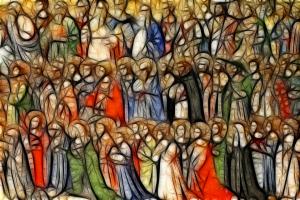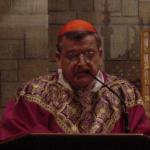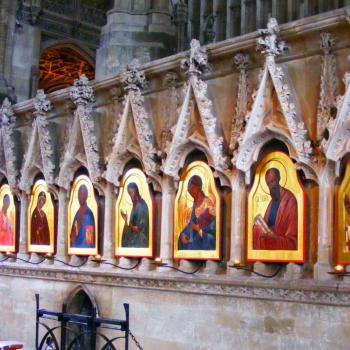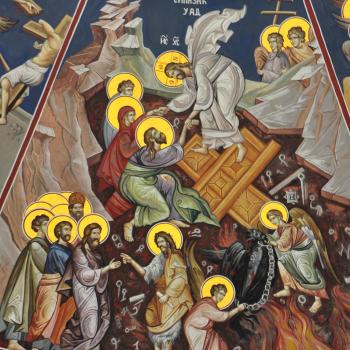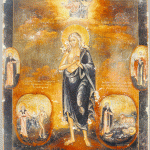“No one after lighting a lamp covers it with a vessel, or puts it under a bed, but puts it on a stand, that those who enter may see the light” (Lk. 8:16 RSV). The stand might be dirty, the stand might have blemishes, the stand might have all kinds of problems: but the light it shines is true light, and those who come into that light share the benefits of that light. This is how we might want to consider the saints: they are the stands, no matter how crooked, broken down or decrepit they might be, which nonetheless let the light shine through them and others, as a result, see and come to the light itself, whereupon they have the chance to partake of the light and share it with others. Saints are holy because they bear the light, but that does not mean they all bear the light equally well.
Similarly, it can be said that holiness radiates. Those who touch that which is holy find it penetrating them, allowing them to radiate that holiness, similar to the way that those who touch radiation find themselves becoming a vessel for that radiation. The difference, of course, between holiness and radiation is that those who come in touch with holiness can befoul it while radiation seems to befoul those who touch it. That is, becoming touched by holiness does not mean someone will necessarily remain holy: those who touch it, those who come in contact with it, can resist it, turn against it, or worse, they can take what has been given and abuse it, turning such holiness against itself in various forms of blasphemy: those who do so endanger themselves.[1]
Those who touch such holiness must cooperate with it, not resist it, if they want it to continue to reside in them. They must let it change them, making them better as a result of their encounter with it. Grace perfects nature, but only when it is not resisted. Holiness can be resisted: it can be denied: grace is not irresistible. However, even if it is denied, even if it is resisted, it still affects those who touch it, so that as long as some aspect of that holiness remains with them, they can still be vessels of grace and holiness for others. Despite what they do, the touch of grace, the touch of holiness, will be upon them, so that others can and will be able to receive some of that holiness by coming in contact with them. Scripture demonstrates this time and time again as someone, like King Saul, receives a share of holiness, which then is shared with others as God works in and through him, despite the fact that he sometimes resisted the will of God and God’s holiness, causing his own internal anxiety and displeasure as a result. Saul was a prophet, and yet he was also in need of David and David’s music to temporarily heal him from the madness which came upon him as a result of his mixed reaction to God’s stamp on his own life.
The radiance of holiness, seen in those who allow holiness to penetrate them and truly become holy throughout, demonstrates itself in a variety of ways. For some, it is the change of life which is openly manifest by that holiness: holiness will grant courage to those who need it, so that those who do some good in the midst of great conflict, such as the martyrs of old, reveal the touch of holiness and its effects in their lives. Others produce change not only in themselves, but others, helping to heal the world through the sense of that holiness: sometimes, such healing will appear miraculous, other times it will be more subtle in form but just as beneficial and long-lasting in its effect.
When the church looks for holiness, when the church looks for those touched by holiness, it does so by trying to see how that holiness was spread to others. It wants evidence; it wants to see people who have been positively affected by and changed by such holiness, similar, again, to the way those who encounter radiation often demonstrate signs of radiation affecting them (such as radiation poisoning). This is why the church looks for miracles in order to verify holiness: such miracles must not be seen as some sort of deus ex machina taking place after the death of a holy person, where God purposefully sends a message to the church to direct our attention to such holiness, waiting for us to call upon that holiness in order to send the message and make everything better. Rather, it is the realization of that holiness being seen in such a person, with the radiation of that holiness noticeable not only in their lives, but the lives of those around them. Recognizing someone as a saint must not be seen as an acceptance of all that such a person has done, but rather, it is the recognition of that touch of holiness in them, that touch of holiness which was shared by them, that touch of holiness with was cooperated with and not resisted: recognition of saints, therefore, is a recognition of the growing eschatological work of Christ as he realizes his work in all of creation, bringing them together as he lets the whole of creation partake of the glory of God.
The recognition of that holiness has manifested itself in many different ways throughout church history. The process of canonization is only one form of such recognition. Before the process of canonization became regulated, popular acclimation often was the means by which holiness was recognized. That is the early saints were recognized by a large populace who knew that they had been in the presence of holiness when they were in the presence of those saints, and they recorded and promotes that recognition far and wide until it became universally accepted. They did not need miracles (though they felt miracles happened through the holiness manifested through the saints). They did not need official proclamations before they began to celebrate and commemorate particular figures as saints. They knew what they experienced and that was enough. Likewise, then, when they preserved the relics of those they believed to be saints, they did this as a means to remain in contact not only with the saints, but the holiness which was in them. When there was a question of whether or not someone was holy or not, whether or not someone should be seen as a saint or not, the feeling of the presence of that holiness while with such relics allowed for such questions to be eliminated.
Christians can, and do, recognize many saints beyond those officially proclaimed to be saints through the process of canonization. Canonization does not place a limit upon who can and cannot be a saint. Indeed, it is only because the faithful recognize such holiness apart from those officially canonized that the church begins to look and consider the canonization process itself. St. Symeon the New Theologian, therefore, could and did perpetuate the holiness of his spiritual director, St. Symeon the Pious, despite the way official theologians denounced St. Symeon the Pious. St. Symeon the New theologians knew the holiness of his mentor: he encountered it, he felt it, he knew it firsthand. Eventually, despite opposition from several theologians, St. Symeon the New Theologian was able to get the Patriarch of Constantinople to affirm the holiness and sainthood of his mentor, but he would not have been able to do that if he required official approval before he accepted and proclaimed the holiness of his own mentor. The church proclaims what becomes obvious to it, to where the holiness remains a focal point of transformation for others, and to make sure that is exactly what is happening, it forms an official investigation to claims of holiness and sainthood. Sometimes, that affirmation takes awhile as holiness can be subtle and only after its slow transformation of many people through the centuries does it become evident enough to be officially proclaimed by the church; sometimes, though rarely, someone radiates great holiness, like St. Francis of Assisi, that it does not take centuries to affirm, but their canonization is fast (though, like with St. John Paul II, not without controversy).
The process of canonization, therefore, must not be mistaken for something more than it is, nor less for what it is. It does not deny the holiness of those who have not been canonized. It does not, likewise, affirm all that those who are canonized have said or done in their lives. Rather, it simply points out that there is a suitably large presence of holiness being radiated by a saint that it becomes silly to deny that holiness. The official process of recognizing that holiness can, and does change. Canonization is a good tool, but it is only a tool, with many human limitations; the holiness it detects is real, but it does not tell us everything about the quality of the person who is touched by that holiness, only that they let their lives be shaped by it and they died without resisting that holiness themselves. Not only are there others who have died with such holiness, others with greater qualities of holiness than many official saints could have died without being recognized, because the purity of their holiness led them to lead a humble life without looking for any personal recognition for themselves. This is why the church reminds us that there is a countless number of saints with the Feast of All Saints, affirming that the canonized saints only form a partial representation of the number of actual saints.
Holiness radiates. The more we find it, the more we encounter it, the more it come positively affect us if we let it. This is why our contact with the saints is important. Through them we have a mediation of God’s grace to us, allowing us to slowly become influenced by it and become better through it. But this is true only if we do not resist it.
[1] Scripture has many instances of those who unjustly try to gain control over that which is holy who suffered a terrible fate for what they have done such as Dathan, Uzzah, and later, Simon Magus.
Stay in touch! Like A Little Bit of Nothing on Facebook.
If you have liked what you read, please consider sharing it with your friends and family!


